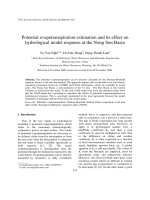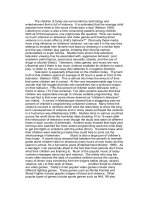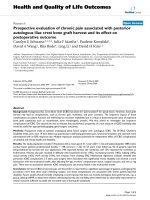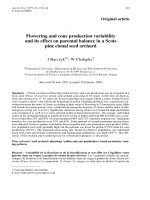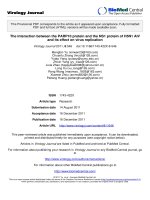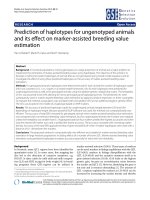Characterization of siderophore producing rhizobacteria and its effect on growth performance of different vegetables
Bạn đang xem bản rút gọn của tài liệu. Xem và tải ngay bản đầy đủ của tài liệu tại đây (212.96 KB, 8 trang )
Int.J.Curr.Microbiol.App.Sci (2017) 6(5): 1398-1405
International Journal of Current Microbiology and Applied Sciences
ISSN: 2319-7706 Volume 6 Number 5 (2017) pp. 1398-1405
Journal homepage:
Original Research Article
/>
Characterization of Siderophore Producing Rhizobacteria and Its Effect on
Growth Performance of Different Vegetables
A. Pahari and B.B. Mishra*
Department of Microbiology, College of Basic Science and Humanities, Orissa University of
Agriculture and Technology, Bhubaneswar - 751 003, Odisha, India
*Corresponding author
ABSTRACT
Keywords
Siderophore,
% SU, Bacillus,
Rhizobacteria
Germination.
Article Info
Accepted:
17 April 2017
Available Online:
10 May 2017
Iron is one of the most essential microelements for virtually all living cells but the
availability of iron is limited due to very low solubility of the dominant ferric iron (Fe 3+) in
soil. Bacteria can produce low molecular weight iron chelating compound called
siderophore. On account of that, an attempt was made in the present investigation to isolate
potential siderophore producing bacteria from different places of Odisha and study their
effect on different vegetables. A total of four siderophore producing bacteria was isolated
from rhizospheric soil sample and amongst them BGBA-1 was found the most efficient
siderophore (76.67% SU) producer. The potential isolates were further characterized for
their different plant growth promoting activities like Indole acetic acid production (IAA),
ammonia production, phosphate solubilisation, N2- fixation and HCN production. From
biochemical and enzymatic characterization, it was found that these two bacteria belonged
to the genus of Bacillus. The potential isolates were further tried with different vegetables
to study the germination percentage, root length and shoot length by Roll towel method. A
significant increase in various parameter of vegetables were observed which was also
statistically significant.
Introduction
Rhizosphere is a dynamic environment which
harbours diverse group of microbes. Some of
the bacteria can pivotal role in the plant
growth, referred to as plant growth promoting
rhizobacteria (PGPR). In the view of
increasing demand for food with deteriorating
environmental quality due to application of
agrochemicals, plant growth promoting
rhizobacteria is steadily increasing in
agriculture as, it supplement fertilizers and
prevent growth of phytopathogens by a wide
range of mechanisms. PGPR can promote the
plant growth by various direct and indirect
mechanism such as phosphate solubilisation,
nitrogen fixation, Indole-3-acetic acid (IAA)
production, siderophore production and
repression of soil borne pathogens by
production of hydrogen cyanide & antibiotics
(Glick, 1995).
Iron is one of the most essential
microelements for virtually all living cells, is
usually abundant in the environment,
particularly in soils. Despite being most
abundant element in earth’s crust, the
availability of iron is limited due to very low
solubility of the dominant ferric iron (Fe3+) in
soil and become unavailable to plants as a
1398
Int.J.Curr.Microbiol.App.Sci (2017) 6(5): 1398-1405
micronutrient (Thompson and Troeh, 1973).
Some bacteria have the capability to produce
low molecular weight (500-1000 dt) metal
chelating compound including iron, called as
Siderophore. Siderophore chelate iron from
mineral phases by formation of soluble Fe3+
complexes that can be taken up energy
dependent membrane transport mechanism
and make it available to plants or bacterial
cells (Ali et al., 2013).
In nature, different types of siderophore such
as hydroxymate, catecholets and carboxylate,
are produced by different bacteria.
Hydroxymate siderophore possess Nhydrosylated amide bonds as co-ordination
sites, catecholates co-ordinate iron with
catecholate hydroxyl group and carboxylates
co-ordinate iron with carboxyl and hydroxyl
groups (Bholay et al., 2012).
Siderophore produced by rhizosphericbacteria
improve rhizosphere colonization and play an
important role in iron mineralization
&supplement to plant (Vansuyt et al., 2007).
Moreover it also play important antagonistic
role against phytopathogens (Chincholkar et
al., 2007b). In recent years, the role of
siderophore-producing PGPR in biocontrol of
soil-borne plant pathogens has created a great
interest as it prevents growth of pathogens by
chelating iron.
On account of that, the present investigation
has been undertaken to isolate the potential
siderophore
producing
bacteria
from
rhizosphere soil of rice from three different
locations of Khurda and Ganjam district of
Odisha, India and the potential isolates were
tried with different vegetables to evaluate the
efficacy in increasing germination (%), root
length and shoot length under in viro
conditions and quantitative analysis of
siderophore production by the isolates was
undertaken.
Materials and Methods
Sample collection and bacterial isolation
Soil sample was collected from the
rhizosphere region of Rice plant from
different locations of khurda and Ganjam
district of Odisha and intact root system was
dug out. The rhizospheric soil sample was
carefully collected in plastic bags under
aseptic conditions. The soil sample was air
dried and subjected to the isolation of bacteria
by spread plate technique. A total of 31
bacteria were isolated from the rhizospheric
soil sample and they are further characterized
for siderophore production.
Screening for siderophore production
Siderophore productions by all the isolates
were tested qualitatively by Chrome Azural S
(CAS) plate assay (Schwyn and Neilands,
1986). Freshly grown bacterial isolates were
inoculated on CAS agar plates and incubated
at 30±2°C for 24-48 hours. After proper
incubation period, siderophore production
was confirmed by the presence of orange
colour zone around the colony on CAS agar
plates and total four positive colonies were
isolated.
Quantification of siderophore
The quantitative estimation of siderophore
produced by isolates was done by the CASshuttle assay, in which the isolates were
grown in succinate medium (Meyer and
Abdallah, 1978) and incubate for 24-48 hr at
30 ±2ºC with constant shaking at 120 rpm.
After the incubation supernatant was collected
and siderophore present in the aliquot was
determined at 630 nm by using formula: [(ArAs)]/Ar x 100, where Ar is the absorbance at
630 nm of reference (CAS assay solution +
uninoculated media) and As is the absorbance
1399
Int.J.Curr.Microbiol.App.Sci (2017) 6(5): 1398-1405
at 630 nm of the sample (CAS assay solution
+ suparnatnt) (Payne, 1994).
In vitro screening of isolates for different
plant growth promoting characters
All rhizobacterial isolates obtained were
screened for different plant growth promoting
traits. Each culture was placed on modified
Pikovskaya agar (Pikovaskya et al., 1948)
with insoluble tricalcium phosphate (TCP)
and incubated at 30±0.1ºC for 5 days to check
the phosphate solubilization. IAA production
was assayed using qualitative method
developed by Bric et al., (1991). Bacterial
cultures were inoculated in nutrient broth with
tryptophan (1mg/ml) incubated at 35±2ºC for
7 days. Cultures were centrifuged at 3000 rpm
for 30 min. 2 mL of supernatant was mixed
with 2 drops of orthophosphoric acid and 4 ml
of Salkowski’s reagent (50 ml, 35%
perchloric acid; 1 ml 0.5 FeCl3). The
development of a pink colour indicated Indole
Acetic Acid (IAA) production (Loper and
Schroth, 1986). Bacterial isolates were tested
for the production of ammonia in peptone
water. Freshly grown cultures were inoculated
in 10 ml peptone water in each tube and
incubated for 48 h at 35±2°C. Nessler’s
reagent (0.5 ml) was added in each tube.
Development of brown to yellow colour
observed was a positive test for ammonia
production (Cappuccino and Sherman, 1992).
Isolates were further screened for HCN
production. Bacterial cultures were streaked
on nutrient agar medium containing 4.4 g/L of
glycine. A Whatman filter paper No. 1 soaked
in 0.5% picric acid solution (in 2% sodium
carbonate) was placed inside the lid of a plate.
Plates were sealed with parafilm and
incubated at 35 ± 2ºC for 4 days (Castric et
al., 1975). For nitrate to nitrite, reduction was
detected during the test. Bacteria were
inoculated into nitrate broth and incubated
incubated at 30 ±1ºC for 96 h. After
inoculation, sulphanillic acid and α-naphthyl
amine mixture (1:1) was added. The
appearance of deep pink colour indicated a
positive result. N2-fixation ability of the
isolates was checked by the using N-free agar
based Jensen (1951) agar media and
incubated for 72 h at 30±1ºC.
Identification,
biochemical
characterization and enzymatic activities of
bacterial isolates
The potential isolates were further
characterized on the basis of their staining
characteristics and further investigated in
terms of biochemical properties like indole,
catalase, urease, citrate, ammonia, nitrate
producing abilities and enzymatic activities
like amylase, cellulase, gelatinase, caesinase
and fermentation of various sugars, which
helped in identifying the bacteria up to genus
level (Gupta et al., 2000) by Bergey’s manual
of Determinative bacteriology (Holt et al.,
1994) and ABIS online software.
Trial with seed germination
Bacterial isolates, BGBA-1, BGBA-2,
BRBA-1 and BRBA-2 were tried with
different vegetables for seed germination
under lab condition. Brinjal (Solanum
melongena
L.),
Okra
(Abelmoschus
esculentus L.) and tomato (Solanum
lycopersicum L.) seeds were collected from
Dept. of Vegetable science, OUAT and were
surface sterilized with 0.1% HgCl2 for 2 min
and rinsed with sterile distilled water for 10
times. Bacterial isolates were grown in
respective broth on shaking incubator (180
rpm) at 28±2°C for 24 h. Cell densities in the
suspension were adjusted to a final density of
approximately 108 CFU seed-1.
The surface sterilized seeds were inoculated
in broth culture for 30 min (ISTA, 1993).
Germination tests were carried out using the
paper towel method. Treated seeds and
1400
Int.J.Curr.Microbiol.App.Sci (2017) 6(5): 1398-1405
control were seeded onto paper towels.
Germination percentage was measured with
the
following
formula:
Germination
percentage = Number of germinated seeds /
Number of seeds in sample × 100. Root
length and shoot length of individual was then
measured.
Statistical analysis
All the experiment was done in triplicate and
the data was analyzed statistically by one way
ANOVA at p˂0.05 significant level.
Results and Discussion
Screening of siderophore positive strain
and Quantitative estimation of siderophore
The siderophore positive isolates were
screened by using the colour change of CAS
reagent from blur to orange in CAS agar
plates. Out of 31 bacterial isolates, four
bacterial isolates i.e. BGAB-1, BGAB-2,
BRABA-1 and BRBA-2 were positive for
siderophore production.
In quantitative estimation of siderophore,
percent of siderophore units were estimated in
terms of percent decolonization. In the present
investigation, it was found that out of four
isolates, BGBA-1 and BRBA-1 produced
76.67 % and 74.56 % (Fig. 1) siderophore
units after 48 hr of incubation period. It was
already proved that the maximum siderophore
production by the Bacillus sp. observed after
48 hr (Pahari et al., 2016).
Plant growth promoting activities of the
bacterial isolates
A total of four siderophore positive bacterial
isolates were further characterized for their
different plant growth promoting activities. It
was observed that out of four bacterial
isolates BGBA-1 and BRBA-1 were positive
for IAA production. IAA in the rhizosphere
depends on the availability of precursors and
uptake of microbial IAA by plant (Arshad and
Frankenberger, 1991; Pradhan and Mishra,
2015). On Pikovskaya medium, BGBA-1,
BGBA-2 and BRBA-1 showed a development
of sharp halo zones (Table 1). Similar
observations has been reported by Ngomle et
al., 2014, who state that microorganisms
capable of producing a clear zone due to P
solubilization in the surrounding medium
were selected as potential phosphate
solubilizers and where clear zones around the
colonies indicated the capacity of phosphate
solubilization on Pikovskaya medium.
Furthermore, all of the bacterial isolates also
exhibited strong production of ammonia from
peptone water (Table 1), which is another
important trait of PGPR and taken up by
plants as a source of nitrogen for their growth
(Ahmad et al., 2008). None of the isolates
were positive for HCN production.
Table.1 Plant growth promoting functions of the isolates
Test
BGBA-1
BGBA-2
BRBA-1
BRBA-2
Siderophore production
+
+
+
+
HCN production
-
-
-
-
NH3 production
+
+
+
+
IAA production
N2 fixation
+
+
-
+
+
-
Phosphate solubilization
+
+
+
-
1401
Int.J.Curr.Microbiol.App.Sci (2017) 6(5): 1398-1405
Table.2 Physiological and biochemical properties of the siderophore producing bacteria
TEST
Catalase
H2S production
Indole
Methyl red test
VP
Nitrate reduction
Urease production
Citrate utilization
Oxidase
Mannitol motility
Aesculin hydrolysis
Anaerobic growth
ONPG
BGBA 1
+
+
+
+
+
+
+
BGBA 2
+
+
+
+
+
-
BRBA 1
+
+
+
+
+
+
+
+
BRBA 2
+
+
+
+
+
+
+
Table.3 Extracellular enzymatic activities of the potential bacterial isolates
Test
BGBA-1
BGBA-2
BRBA-1
BRBA-2
Gelatinase
Casein hydrolysis
+
+
+
+
+
+
+
-
Tributyrin
+
+
+
-
Amylase
+
+
+
+
Cellulase
+
-
+
-
Chitin hydrolysis
Pectin hydrolysis
+
+
+
+
DNase
-
-
-
-
Lecithinase
-
-
-
-
Table.4 Identification of bacterial isolates by ABIS online software
Isolate No.
Identification
Matching %
BGBA-1
Bacillus licheniformis
76%
BGBA-2
Bacillus coagulans
82%
BRBA-1
Bacillus circulans
75%
BRBA-2
Bacillus niacin
83%
1402
Int.J.Curr.Microbiol.App.Sci (2017) 6(5): 1398-1405
Table.5 Sugar utilization by the siderophore producing bacteria
Isolate
No.
Control
BGBA 1
BGBA 2
BRBA 1
BRBA 2
Root
length
(cm)
4.19
±
0.37
5.92
±
0.32
5.16
±
0.25
5.35
±
0.27
5.32
±
0.34
Brinjal
Shoot
Germination
length
%
(cm)
6.10
43.7
±
±
0.30
1.20
8.73
69.6
±
±
0.40
1.45
8.00
51.0
±
±
0.41
2.30
8.50
62. 5
±
±
0.33
2.18
8.17
61. 7
±
±
0.34
1.44
Root
length
(cm)
6.55
±
0.22
10.08
±
0.25
7.87
±
0.28
9.93
±
0.33
9.96
±
0.57
Okra
Shoot
Germination
length
%
(cm)
8.34
60.34
±
±
0.20
0.88
12.02
82.00
±
±
0.35
2.30
10.2
69.00
±
±
0.29
1.52
11.39 ±
77.33
0.34
±
1.20
10.13 ±
63.34
0.50
±
1.21
Root
length
(cm)
4.76
±
0.25
6.22
±
0.77
5.32
±
0.22
7.22
±
0.46
5.03
±
0.19
Tomato
Shoot
Germination
length
%
(cm)
8.93
50.67
±
±
0.22
2.40
11.06
73.00
±
±
0.25
3.21
10.17
65.00
±
±
0.21
1.73
10.47
71.67
±
±
0.27
1.86
9.65
61.00
±
±
0.24
1.16
Values represents mean ±SE and highly significant at p <0.05
Table.6 Effect of siderophore producing plant growth promoting rhizobacteria on germination
percentage, root length and shoot length of different vegetables in germination paper
Isolate No.
BGBA 1
BGBA 2
BRBA 1
BRBA 2
Tre
+
+
+
De
+
+
+
+
Du
+
+
+
+
Sa
+
+
+
+
Ga
-
Ino
+
+
+
Me
+
+
+
So
+
+
+
+
Ma
+
+
+
+
Su
-
La
+
+
+
+
Rh
+
+
+
+
Mn
+
-
Ce
+
+
+
-
Glu
+
+
+
+
Tre: Trehalose, De: Dextrose, Du: Dulcitol, Sa:Salicin, Ga: Galactose, Ino: Inositol, Me: Melibiose, So: Sorbitol,
Ma: Maltose, Su: Sucrose, La: Lactos, Rh: Rahmmose, Mn: Mannose, Ce: Cellobiose, Glu:Glucose
Fig.1 Quantification of Siderophore produced by the bacterial isolates
1403
Int.J.Curr.Microbiol.App.Sci (2017) 6(5): 1398-1405
Biochemical
Identification
characterization
and
The biochemical tests such as oxidase test,
nitrate reduction, catalase, carbohydrate
utilization, citrate utilization, Indole were
carried out for phenotypic identification of
isolates (Holt et al., 1994). All of the
siderophore producing isolates were positive
for maximum biochemical and enzymatic
activities (Tables 2 and 3). All of the isolates
were positive for maximum sugar utilization
(Table 5). The bacterial isolate were
characterized by biochemical attributes and
were identified as BGBA-1 (Bacillus
licheniformis), BGBA-2 (Bacillus coagulans),
BRBA-1 (Bacillus circulans) and BRBA-2
(Bacillus niacini) on the basis of ABIS online
software (Table 4).
Seed germination test
In this study, an increase in plant growth by
seed bacterization has been demonstrated.
Plant growth promoting rhizobacteria
increased the synthesis of gibberellins, which
would have triggered the activity of specific
enzymes including amylase to promote early
germination, which have brought an increase
in availability of starch assimilation (Bharathi
et al., 2004). It is a well-established fact that
overall plant growth and root development
influenced by improved phosphorous
nutrition (Jones et al., 1994). A large number
of evidence suggests that PGPR enhance the
growth, seed emergence and crop yield
(Herman et al., 2008). In the present study, it
was found that all of the isolates significantly
increased the germination percentage, root
and shoot length of brinjal, okra and tomato,
over control (Table 6). Highest root (10.08
cm), shoot elongation (12.02 cm) and
germination (82%) was recorded when okra
seeds were pre-treated with BGBA-1.
The bacteria isolated for the rhizosperic
region of rice plant is identified as species of
Bacillus and it is evident from the finding that
along with showing positive in many plant
growth promoting traits, it is increasing
germination, root length and shoot length of
different like Brinjal, Tomato and Okra. The
increase in the growth parameters is also
statistically significant. With further research,
the organism can be of great agricultural
importance with its application in crop field.
Acknowledgement
The authors are thankful to Staff of the
Department of Vegetable science, OUAT for
providing laboratory facilities during the
period of study. The authors have no conflict
of interest to declare.
References
Ahmad, F., I. Ahmad and M.S. Khan. 2008.
Screening of free-living rhizobacteria for
their multiple plant growth promoting
activities. Microbiol. Res., 163: 173-181.
Arshad, M. and W.T. Frankenberger. 1991.
Microbial production of plant hormones.
Plant Soil, 1(133): 1-8.
Ali, S.S. and Vidhale, N.N. 2013. Bacterial
Siderophore and their Application: A
review. IJCMAS, 2: 303-312.
Bholay, A.D., Jadhav Priyanka, U., Borkhataria,
B.V., Mayuri, V., Dhalkari. 2012
Fluorescent Pseudomonads as Plant
Growth Promoting Rhizobacteria and
Their Siderophoregenesis. IOSR J.
Pharmacy and Biol. Sci., (IOSRJPBS),
Volume. 3, pp. 27-32.
Bric, J.M., R.M. Bostock and S.E. Silverstone.
1991. Rapid in situ assay for indole acetic
acid production by bacteria immobilized
on a nitrocellulose membrane. Appl.
Environ. Microbiol., 57: 535-538.
Cappuccino, J.C. and N. Sherman. 1992.
Microbiology. In: A Laboratory Manual
(Eds.:
3rd).
New
york,
Benjamin/cummings Pub. Co., p.125–
179.
Castric, P.A. 1975. Hydrogen cyanide, a
1404
Int.J.Curr.Microbiol.App.Sci (2017) 6(5): 1398-1405
secondary metabolite of Psuedomonas
aeruginosa. Can. J. Microbiol., 21: 613618.
Chincholkar, S.B., Chaudhari, B.L., Rane, M.R.
and Sarode, P.D. 2007b. Fungal
phytopathogen
suppression
using
siderophoregenic bio-inoculants. In:
Biological Control of Plant Diseases:
Current Concepts. Chincholkar, S. B. and
Mukerji, K.G. (eds). Haworth Press,
USA, pp. 401-417.
Glick, B.R., 1995. The enhancement of plant
growth by free-living bacteria. Can. J.
Microbiol., 41: 109-117.
Gupta, A., M. Gopal and K.V. Tilak. 2000
Mechanism of plant growth promotion by
rhizobacteria. Indian J. Exp. Biol., 38:
856–862.
Herman, M.A.B., Nault, B.A. and Smart, C.D.
2008. Effects of plant growth promoting
rhizobacteria on bell pepper production
and green peach aphid infestations in
New York, 27: 996-1002.
Holt, J., N. Krieg, P. Sneath, J. Staley and S.
Williams. 1994. Bergey's manual of
determinative bacteriology. Williamson
and Wilkins.
ISTA. 1993. Proceedings of the international
Seed Testing Association, International
Rules for Seed Testing. Seed Sci.
Technol., 21: 25–30.
Jensen, H.L. 1951. Notes on the biology of
Azotobacter, Proceedings of the Society
for Applied Bacteriology.
Jones, D.L., Darrah, P.R. and Kochian, L.V.
1994. Amino acid influx at the soil root
interface of Zea mays L. and its
implications in the rhizosphere. Plant and
Soil, 163: 1-12.
Loper, J.E. and M.N. Schroth. 1986. Influence
of bacterial source of indole-3-acetic acid
of root elongation of sugar beet. Phyto
Pathol., 76: 386-389.
Ngomle, S., P.M. Bhattacharya., A. Roy and
B.S. Ambesh. 2014 Isolation and
screening of phosphate solubilizing
Bacteria from different crop rhizosphere.
The Ecoscan, 6: 505-509.
Pahari, A., Dangar, T.K. and Mishra, B.B.
2016. Siderophore quantification of
bacteria from sundarban and its effect on
growth of brinjal (Solanum melongena
L.). The Bioscan, 11(4): 2147-2151.
Payne, S.M. 1994. Detection, isolation and
charectarization of siderophore. Methods
of Enzymol., 235: 329-344.
Pikovaskya, R.I. 1948. Mobilization of
phosphorus in soil in connection with the
vital activity of some microbial species.
Mikrobiologiya, 17: 362-370.
Pradhan, A. and B.B. Mishra. 2015. Effect of
Plant Growth Promoting Rhizobacteria on
germination and Growth of Rice (Oryza
Sativa L.).The Ecoscan, 9(1&2): 213-216.
Schwyn, B. and Neilands, J.B. 1986. Universal
Chemical Assay for the detection and
determination of siderophores. Anal.
Biochem., 140: 47-56.
Thompson, L.M. and F.R. Troeh. 1973. Soils
and Soil Fertility, third ed. McGraw-Hill
Book Company.
Vansuyt, G., Robin, A., Briat, J.F., Curie, C.
and Lemanceau, P. 2007. Iron acquisition
from Fe-pyoverdine by Arabidopsis
thaliana.
Molecular
Plant-Microbe
Interactions, 2: 441-447.
How to cite this article:
Pahari, A., and Mishra, B.B. 2017. Characterization of Siderophore producing Rhizobacteria
and its Effect on Growth Performance of Different Vegetables. Int.J.Curr.Microbiol.App.Sci.
6(5): 1398-1405. doi: />
1405
